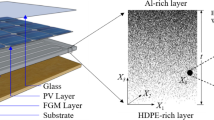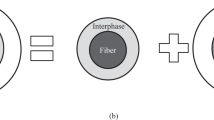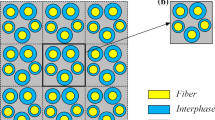Abstract
In order to represent the functionally graded properties of interphase, a multi-coated micromechanical model is developed. Based on elliptic shell integration of Green’s function, the strain disturbance in each phase is obtained. According to computational investigation of this model, the outer layer of the interphase does not bring in strain disturbance within the inner ones. To this end, a sequential computational homogenization method is proposed. The inhomogeneities are added sequentially from outside to inside. The temporary effective modulus on each stage is obtained by the Self Consistency Scheme. Then the effective modulus of the overall composites are fitted with a Mori–Tanaka estimation for practical applications. The effectiveness of present method is verified by the results of “2 + 1” and “3 + 1” models in prior researches and finite element simulations. Finally, the influence of thickness and stiffness of interphase on the composites’ effective modulus are investigated.


















Similar content being viewed by others
References
Torralba JM, Velasco F, Costa CE, Vergara I, Cáceres D (2002) Mechanical behaviour of the interphase between matrix and reinforcement of Al 2014 matrix composite reinforced with (Ni3Al). Compos Part A Appl Sci Manuf 33(3):427–434
George SC, Thomas S (2001) Transport phenomena through polymeric systems. Prog Polym Sci 26(6):985–1017
Christensen RM, Lo KH (1979) Solutions for effective shear properties in three phase sphere and cylinder models. J Mech Phys Solids 27:315–330
Giambanco G, Scimemi GF, Spada A (2012) The interphase finite element. Comput Mech 50(3):353–366
Odegard GM, Clancy TC, Gates TS (2005) Modeling of the mechanical properties of nanoparticle/polymer composites. Polymer 46:553–562
Shandiz SA, Montazeri A (2016) A novel MD-based procedure to obtain the interphase Young’s modulus in nanocomposites. Comput Mater Sci 113:104–111
Li Y, Liu Z, Jia Z, Liu WK, Aldousari SM, Hedia HS, Asiri SA (2017) Modular-based multiscale modeling on viscoelasticity of polymer nanocomposites. Comput Mech 59:187–201
Gassan J, Gutowski VS (2000) Effects of corona discharge and UV treatment on the properties of jute-fibre epoxy composites. Compos Sci Technol 60:2857–2863
Marais S, Gouanve F, Bonnesoeur A, Grenet J, Poncin-Epaillard F, Morvan C, Metayer M (2005) Unsaturated polyester composites reinforced with flax fibers: effect of cold plasma and autoclave treatments on mechanical and permeation properties. Compos Part A Appl Sci Manuf 36:975–986
Pothan LA, Thomas S (2003) Polarity parameters and dynamic mechanical behavior of chemically modified banana fiber reinforced polyester composites. Compos Sci Technol 63:1231–1240
Goda K, Sreekala MS, Gomes A, Kaji T, Ohgi J (2006) Improvement of plant based natural fibers for toughening green composites-effect of load application during mercerization of ramie fibers. Compos Part A Appl Sci Manuf 37:2213–2220
Karger-Kocsis J, Mahmood H, Pegoretti A (2015) Recent advances in fiber/matrix interphase engineering for polymer composites. Prog Mater Sci 73:1–43
Boddu VM, Brenner MW, Patel JS (2016) Energy dissipation and high-strain rate dynamic response of E-glass fiber composites with anchored carbon nanotubes. Compos Part B 88:44–54
Zhang Y, Zhao J, Jia Y, Mabrouki T, Gong Y, Wei N, Rabczuk T (2013) An analytical solution on interface debonding for large diameter carbon nanotube-reinforced composite with functionally graded variation interphase. Compos Struct 104:261–269
Schoneich M, Zamanzade M, Stommel M (2015) Fiber-matrix interphase in applied short glass fiber composites determined by a nano-scratch method. Compos Sci Technol 119:100–107
Kundalwal SI, Kumar S (2016) Multiscale modeling of stress transfer in continuous microscale fiber reinforced composites with nano-engineered interphase. Mech Mater 102:117–131
Yan W, Ge W, Smith J, Lin S, Kafka OL, Lin F, Liu WK (2016) Multi-scale modeling of electron beam melting of functionally graded materials. Acta Mater 115:403–412
Nazarenko L, Stolarski H, Altenbach H (2017) A model of cylindrical inhomogeneity with spring layer interphase and its application to analysis of short-fiber composites. Compos Struct 160:635–652
Nazarenko L, Stolarski H, Altenbach H (2016) Effective properties of short-fiber composites with Gurtin–Murdoch model of interphase. Int J Solids Struct 97–98:75–88
Aldakheel F, Wriggers P, Miehe C (2018) A modified Gurson-type plasticity model at finite strains: formulation, numerical analysis and phase-field coupling. Comput Mech 62:815–833
Benveniste Y, Miloh T (2001) Imperfect soft and stiff interfaces in two-dimensional elasticity. Mech Mater 33:309–323
Benveniste Y (2006) A general interface model for a three-dimensional curved thin anisotropic interphase between two anisotropic media. J Mech Phys Solids 54:708–734
Eshelby JD (1957) The determination of the elastic field of an ellipsoidal inclusion and related problems. Proc R Soc Lond Ser A 241:376–396
Mura T (1987) Micromechanics of defects in solids. Martinus Nijhoff Publishers, Dordrecht
Trotta S, Marmo F, Rosati L (2017) Evaluation of the Eshelby tensor for polygonal inclusions. Compos Part B 115:170–181
Trotta S, Marmo F, Rosati L (2016) Analytical expression of the Eshelby tensor for arbitrary polygonal inclusions in two-dimensional elasticity. Compos Part B 106:48–58
Liu Z, Moore JA, Aldousari SM, Hedia HS, Asiri SA, Liu WK (2015) A statistical descriptor based volume-integral micromechanics model of heterogeneous material with arbitrary inclusion shape. Comput Mech 55(5):963–981
Li S, Sauer RA, Wang G (2007) The Eshelby tensors in a finite spherical domain—part I: theoretical formulations. J Appl Mech 74:770–783
Li S, Sauer RA, Wang G (2007) The Eshelby tensors in a finite spherical domain—part ii: applications to homogenization. J Appl Mech 74:784–797
Shi C, Tu Q, Fan H, Rios CAO, Li S (2016) Interphase models for nanoparticle-polymer composites. J Nanomech Micromech 6(2):04016003
Shi C, Tu Q, Fan H, Li S (2016) An interphase model for effective elastic properties of concrete composites. J Micromech Mol Phys 1(1):1650005-1-19
Hashin Z, Shtrikman S (1963) A variational approach to the theory of the elastic behavior of multuphase materials. J Mech Phys Solids 11(42):127–140
Eshelby JD (1961) Elastic inclusions and inhomogeneities. Prog Solid Mech 2:89–104
Mori T, Tanaka K (1973) Average stress in matrix and average elastic energy of materials with misfitting inclusions. Acta Metall 21(5):571–574
Hill R (1965) A self-consistent mechanics of composite materials. J Mech Phys Solids 4:213–222
Dinzart F, Sabar H (2017) New micromechanical modeling of the elastic behavior of composite materials with ellipsoidal reinforcements and imperfect interfaces. Int J Solids Struct 108:254–262
Liu Z, Moore JA, Liu WK (2016) An extended micromechanics method for probing interphase properties in polymer nanocomposites. J Mech Phys Solids 95:663–680
Liu WK, Fish J, Chen JS, Camanho PP (2016) Preface: special issue of computational mechanics on “Connecting multiscale mechanics to complex material design”. Comput Mech 57(3):1–3
Johnson KL, Rodgers TM, Underwood OD, Madison JD, Ford KR, Whetten SR, Dagel DJ, Bishop JE (2018) Simulation and experimental comparison of the thermo-mechanical history and 3D microstructure evolution of 304L stainless steel tubes manufactured using LENS. Comput Mech 61(5):559–574
Hori M, Nemat-Nasser S (1993) Double-inclusion model and overall moduli of multi-phase composites. Mech Mater 14:189–206
Nemat-Nasser S (2000) Multi-inclusion method for finite deformations: exact results and applications. Mater Sci Eng, A 285:239–245
Rao YN, Dai HL (2017) Micromechanics-based thermo-viscoelastic properties prediction of fiber reinforced polymers with graded interphases and slightly weakened interfaces. Compos Struct 168:440–455
Herve-Luanco E (2017) Simplification of the (n + 1)-phase model and its extension to non-linear behavior. Int J Solids Struct 121:135–147
Sabiston T, Mohammadi M, Cherkaoui M, Levesque J, Inal K (2016) Micromechanics for a long fibre reinforced composite model with a functionally graded interphase. Compos Part B 84:188–199
Sabiston T, Mohammadi M, Cherkaoui M, Levesque J, Inal K (2016) Micromechanics based elasto-visco-plastic response of long fibre composites using functionally graded interphases at quasi-static and moderate strain rates. Compos Part B 100:31–43
Xu Y, You T, Du C (2015) An integrated micromechanical model and BP neural network for predicting elastic modulus of 3-D multi-phase and multi-layer braided composite. Compos Struct 122:308–315
Xu Y, Zhang W, Bassir D (2010) Stress analysis of multi-phase and multi-layer plain weave composite structure using global/local approach. Compos Struct 92:1143–1154
Xu Y, Zhang P, Lu H, Zhang W (2015) Hierarchically modeling the elastic properties of 2D needled carbon/carbon composites. Compos Struct 133:148–156
Dinzarta F, Sabara H, Berbenni S (2016) Homogenization of multi-phase composites based on a revisited formulation of the multi-coated inclusion problem. Int J Eng Sci 100:136–151
Liu J, Bosco E, Suiker ASJ (2018) Multi-scale modelling of granular materials: numerical framework and study on micro-structural features. Comput Mech 63(2):409–427
Liu Z, Bessa MA, Liu WK (2016) Self-consistent clustering analysis: an efficient multi-scale scheme for inelastic heterogeneous materials. Comput Methods Appl Mech Eng 306:319–341
Tang S, Hou TY, Liu WK (2006) A pseudo-spectral multiscale method: interfacial conditions and coarse grid equations. J Comput Phys 213(1):57–85
Acknowledgements
This work was supported by the Fund of Intelligent Robotic in Ministry of Science and Technology of the People’s Republic of China (Grant Numbers No. 2017YFB1301703), the Fund for distinguished Young Scholars in Shaanxi Province of China (Grant Numbers No. S2018-jc-jq-0260), the Fund on the Guidence of Technology Inovation in Shaanxi Province of China (Grant numbers No. S2018-YD-CGHJ-0014), and Beijing Institute of Collaborative Innovation. The author would like to acknowledge the editors and the anonymous referees of their insightful comments.
Author information
Authors and Affiliations
Corresponding authors
Additional information
Publisher's Note
Springer Nature remains neutral with regard to jurisdictional claims in published maps and institutional affiliations.
Rights and permissions
About this article
Cite this article
Cheng, Y., Cheng, H., Zhang, K. et al. A sequential homogenization of multi-coated micromechanical model for functionally graded interphase composites. Comput Mech 64, 1321–1337 (2019). https://doi.org/10.1007/s00466-019-01712-4
Received:
Accepted:
Published:
Issue Date:
DOI: https://doi.org/10.1007/s00466-019-01712-4




